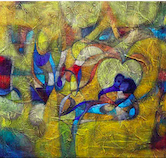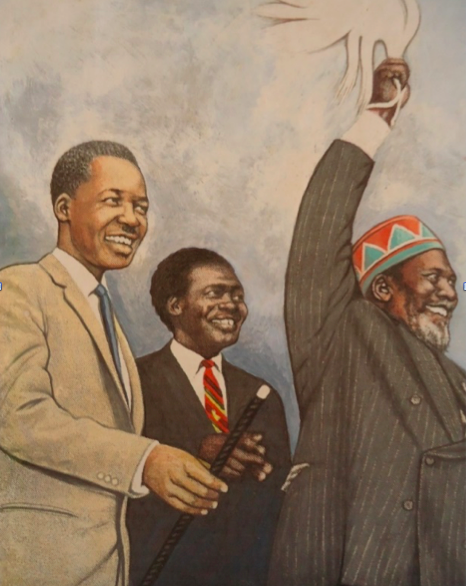In 1953, Margaret Trowell and Klaus Wachsman wrote a book entitled Tribal Crafts of Uganda. It was the first effort to compile an inventory of Uganda’s cultural artifacts and it remains the only publication so far on the subject that provides a concrete description of Uganda’s rich cultural heritage. As the title suggests, the authors’ treatment of the subject was colored by a colonial bias. The authors speculated that African people did not produce art, often referred to as easel painting; rather, they produced ethnographic objects motivated by practical needs in their physical and spiritual cosmoses. To this end, Trowell and Wachsman, did not appraise objects of aesthetic merit, an attribute that was reserved for Western art. Assessing traditional artifacts, presented pitfalls to many Western scholars of African art who habitually focused on apparent visual impressions, who paid little or no attention to associated belief systems in which the art objects are shrouded. [FIG 01].
![[FIG 01] Kefa Ssempangi, Painting, 1960s](https://eaman.belvadigital.com/wp-content/uploads/2024/09/Fig-01_02_Kefa-Sssempangi_Painting_George-Ky.jpg)
THE DUAL STATUS OF TRADITIONAL ART FORMS—ALSO PRESENT IN MUSIC, BODY ART, POETRY AND STORY-TELLING - PROVIDES A PERFECT ENTRY POINT FOR MODERN AFRICAN ARTISTS, PARTICULARLY IN THE INDEPENDENCE DECADE. THEY MOBILISE IT AND CONSTRUCT A NEW MODERNISM THAT SPEAKS TO THE HOPES AND FEARS OF THEIR TIME.
Following from the advent of evangelization, at the turn of the 19th century, Indigenous art forms were marginalised and decentralised. This created tensions, which the Kabaka (king) Daudi Chwa of Buganda (1893-1939) referred to as the foreignisation of his country. He wrote: …..instead of the Baganda acquiring proper education at the various schools and of availing themselves of the legitimate amenities of civilization the young generation of this country are merely drifting in whole sale ‘foreignisation’ of their natural instincts and is discarding its native and traditional customs habits and good breedings. (Chwa 1935, 108)
Chwa’s nationalistic pronouncements and concerns were recognized by Margaret Trowell in her embryonic Art School at Makerere, which was formalised in 1940. Her denigration of the indigenous arts notwithstanding, Trowell, maintained an ideological stance where she pushed for an art education that would restore to her students “a kind of national pride in the achievements of their ancestors” (Trowell 1945). With that in mind, she wrote an art curriculum that resulted in what her critics termed as ‘impulsive art’ because of its emphasis on journalistic imagery as opposed to careful observation.
![[FIG 02] Uganda Museum](https://eaman.belvadigital.com/wp-content/uploads/2024/09/FIG-02_03_Uganda-Museum_display.jpg)
In 1907 Sir Hesketh Bell, the governor of Uganda, (a young overseas British territory), set up a Museum on old Kampala Hill [FIG 02]. It was the first step in archiving both the tangible and intangible heritage of Uganda, which was being overshadowed by modern lifestyles. Sir Hesketh Bell’s Uganda Museum project confirmed that colonial intervention in Africa ignited an unprecedented modernization processes with a resultant fracturing of social life. Education and evangelization justified rendering artifacts from the past inconsistent with modern developments – but, historically valuable and as such worth preserving. The museum project was a novel idea: it however, did not receive adequate investment and for a long time the collection remained an “unclassified junk shop” (Sicherman 2003). Christian Ugandans began referring to the museum as a “House of charms” [ennyumba y’amayembe] accepting the Trowellian re-definition of the objects as “rich collection of fetishes and other witchcraft material” (Trowell 1957,71-72). The collected objects with their changed fixed temporality and ethnographic purposes, confirmed the colonial construction of the ‘natives’.
THE THINGFICATION (CéSAIRE) OF OBJECTS SUCH AS CHARMS AS ETHNOGRAPHIC ENFORCED A STEREOTYPICAL ASSESSMENT OF ‘THE AFRICAN’ AS SUPERSTITIOUS RETROSPECTIVELY JUSTIFYING THE URGENCY OF EVANGELISATION AND DELIVERANCE FROM ‘HEATHEN WORSHIP’.
![[FIG 03] Uganda Museum display](https://eaman.belvadigital.com/wp-content/uploads/2024/09/FIG-03_02_Uganda-Museum.jpg)
In delivering a biased museum, Sir Hesketh Bell’s museum distinguished itself as an accomplice in ostracizing the young Africans for their past traditions – acknowledging the spiritual and material achievements of their forefathers with shame and disavowing them – considering them ‘backward’ and an impediment to progress [FIG 03]. This scenario was changed with the arrival in Uganda of Mrs. Margaret Trowell in 1935. A Slade Art School and School of Education University of London graduate, Trowell volunteered as honorary Museum curator in 1939. She traversed the country with an eye on collecting a broader range of artifacts for the Museum, transcending Sir Hesketh Bell’s narrow conception of what was appropriate to preserve. It was her desire to preserve all that was best in the traditional craftsmanship and to that end she organized her Museum into sections that included weaponry, food preservation, hunting and more to create a more inclusive collection.
![[FIG 04] Pilkington Ssengendo, Kampala Roof Tops, 1984, Oil on hardboard](https://eaman.belvadigital.com/wp-content/uploads/2024/09/FIG-04_02_Pilkington-Ssengendo_Kampala-Roof-Tops_1984-Oil-on-hardboard-.png)
It was nonetheless an uphill task, convincing her students that African life in the rural was invaluable and must not be obscured by modernity. To illustrate this, she asked for information on crafts, and one of her students remarked, “Madame, I know nothing of these things, am I not an educated man?” (Trowell, 1957). Undeterred by such pessimistic remarks, Trowell pressed ahead with the informal art classes at her residence culminating into the first art exhibition ever, at Namirembe Synod Hall. Opened by Lord Hailey in 1939, a version of this exhibition, together with a selection of material culture from the Uganda Museum, were held at the Imperial Institute, London, underlining her determination to re-awaken past traditions – still surviving in the rural – along modern lines.
KEFA SSEMPANGI, PILKINGTON SSENGENDO, FRANCIS NNAGGENDA AND PETER MULINDWA ARE THE FOUR ARTISTS I AM PRESENTING, WHO RESOLUTELY INTERROGATED THE UGANDAN COSMOLOGICAL REALM, GENERATING VISUAL CONTENT THAT CELEBRATED THE POWER AND ENERGY, THE DEVOTEES OF ANCESTRAL WORSHIP WERE DRAWN TO.
![[FIG 05] Francis Nnaggenda, Untitled (Blue Bull), 1986,oil on canvas mounted on board](https://eaman.belvadigital.com/wp-content/uploads/2024/09/FIG-05_02_Francis-Nnaggenda_Untitled-Blue-Bull_1986_oil-on-canvas-mounted-on-board-copy.jpg)
![[FIG 06] Peter Mulindwa, 1970s](https://eaman.belvadigital.com/wp-content/uploads/2024/09/FIG-06-Peter-Mulindwa-1970s.jpg)
These artists, though not Trowell’s direct students, benefitted from her traditionalising approach. Ironically, it is their contestation of Cecil Todd’s privileging of academic art during the independence decade that provided the needed nourishment for their visceral analysis of the cosmos [FIGs 04, 05 and 06].
Todd, Trowell’s successor (1958), had maintained a disparaging attitude towards Trowell’s art education pedagogy calling it paternalistic and naive — inconsistent with the needs and challenges of an emerging modern African society. He redirected the School into an academic framework, where technique and knowledge of the wider world through history dominated the curriculum. For Todd, African artifacts had lost their currency and as such, of little value in driving African modernity beyond their formal properties.
![[FIG 07] Kefa Ssempangi, Sculpture, 1970s, Kampala](https://eaman.belvadigital.com/wp-content/uploads/2024/09/FIG-07_02_Kefa-SSempsangi_-Sculpture_Makerere.jpg)
Todd’s obsession with academic art brewed discontent and criticism from his students who accused him of perpetuating a colonial legacy that undermined local content. Parallel perspectives emerged and flourished, framed within and validated by political and cultural debates at Makerere and elsewhere in the country…. debates that sought to open the minds of post-independence young Africans to be more culturally conscious as they constructed a new African reality. Kefa Ssempangi, was at the forefront of re-engaging with the cosmological past, creating enigmatic objects with roots in the African divination rituals.
![[FIG 08] Cecil Todd, Exchange and Barter, 1960s, Mural, Makerere Art School](https://eaman.belvadigital.com/wp-content/uploads/2024/09/FIG-08-Cecil-Todd-Exchange-and-Barter-1960s-Mural-Makerere-Art-School.jpg)
Born in 1940, Kefa Ssempangi grew up in a family that practiced ancestral worship. As a Christian and an educated young man, he understood the trickery used in the healing processes. He knew that the psychological support from the diviners was the curing agent, rather than the herbal concoctions, which were often accompanied by taboos. In Nyiize, a village where Ssempangi grew up, people sacrificed eggs and chickens to an ancestral snake so that barren women might conceive [FIG 07]. This practice inspired a sculpture in cement, in which human forms are struggling to break from the tight clasp of the spirits. Interestingly, the people who visited the diviners were professed Christians, a duality that seemed to be a contradiction yet essential for maintaining a link with the past. Ssempangi had great admiration for this ecosystem, because he believed its honest interrogation would lead to a culturally conscious Christianity.
Although he represented ideas that run counter to the spirit Pan-Africanism, Todd appealed to students who extolled the precepts of Western academism in art [FIG 08]. One of his best-known pieces – Exchange and Barter is unequivocal in its technical rendering. Symbols of currency from history and the recent past are used as motifs to generate a mosaic where composition and color harmony are on display. Elements and principles of design, as Pilkington Ssengendo reminisces, helped to anchor the School in an academic realm. Speaking at the Africa 95 conference in London, he said, and I paraphrase: “We at Makerere Art School where I teach, we are unencumbered by the weight of past traditions—we are concerned about challenges of the present times which we represent in picture”– a pronouncement that did not go well with the Nigerian participants at the conference. Whether baskets or mats, they retorted, that is your inheritance and you must value it.
IT WAS A TURNING POINT FOR SSENGENDO WHO UPON HIS RETURN, UNDERSTOOD THAT TRUE AFRICAN MODERNISM DID NOT COME FROM IN DISREGARDING HIS INHERITANCE BUT RATHER, PAYING SINGULAR ATTENTION TO INDIGENOUS KNOWLEDGE WAS VITAL.
![[FIG 09] Pilkington Ssengendo, King and Queen, oil and bark-cloth](https://eaman.belvadigital.com/wp-content/uploads/2024/09/FIG-09_02_Pilkington-Ssengendo_King-and-Queen_Ganda.jpg)
![[FIG 10] Pilkington Ssengendo, King and Queen, oil and bark-cloth](https://eaman.belvadigital.com/wp-content/uploads/2024/09/FIG-11-Pilkington-Ssengendo-King-and-Queen-Detail.jpg)
He became one of the severe critics of Cecil Todd’s pedagogy claiming that as a student under Todd, he was not exposed to traditional art, which should have enabled him to ‘facture’ as he normally put, art of cultural consciousness. He resolved to make it. As a painter, Ssengendo picked on bark-cloth to investigate its artistic potential in terms of the range of colors it provides as well as the cultural sentiments he and others attached to it. Today, it has lost many of its practical functions, but nonetheless it still lives in the identity and consciousness of the Ganda. As a painter, he has extended this ancient material beyond its traditional role and turned it into a material for painting. For Ssengendo a Ganda himself moreover with a royal connection, thus for him bark-cloth carries a special significance.
In the painting King and Queen, Ssengendo combines the bark-cloth and modern paint to conceptualize the royal Ganda couple [FIG 10]. Here, elements of modernity (oil paint) and tradition (bark-cloth) are juxtaposed in an incongruous way, as if to imply that the old has been made to sit uneasily with the new. The design of the crown is reminiscent of the recent coronation (1995) of the reigning Kabaka Ronnie Muwenda Mutebi. Curiously it is atop a figure dressed in the pre-colonial style; a bark cloth with a knot tied above the left hand shoulder. Yet another co-existence of old and new in this painting is the presence of ensiriba, a protective magical fetish against malevolent spirits, strapped on the King’s right hand, while the left is adorned with a modern wristwatch. The queen too poses a riddle. For the fact that her breasts are exposed goes against the code of modesty especially as expected of a Nnabagereka (Ganda queen). In the background the Royal Soldiers are on guard, while the misty huts bring resonances of Ganda architecture of the past.
THIS PAINTING IS A COMPLEX TAPESTRY OF LOCAL AND MODERN MATERIALS AND EXPERIENCES.
Some of the objects like the beads speak about the local values of chastity and purity. Married women commonly wear beads around their waists under their clothing to enhance their sensuality and as a pledge of faithfulness to their spouses. In this painting, beads loosely hang from Nnabagereka’s body as if to suggest that morality in modern times has come under strain.
![[FIG 11] Francis Nnaggenda, The Forest Spirit, wood and cooper sheets, front](https://eaman.belvadigital.com/wp-content/uploads/2024/09/FIG-11_02_Nnaggenda_The-Forest-Spirit_wood-and-coppersheets.jpg)
In King and Queen, bark-cloth, jute cloth and cotton cloth are stitched together and unified by the smudgy paint [FIG 11]. Stitching is an important aspect of bark cloth making. Most if not all bark-cloths would require frequent patching up. The materials, which the painter might have picked from a rubbish heap, have an organic tactile quality. The juxtaposition of their varying textures creates a strong visual impression. They are themselves objects of visual interest in their individual capacities as they are in their corporate alliance in the context of the overall appearance of the painting. The high saturation of reds and browns in King and Queen is deliberate to link the painting to the idea of bark-cloth.
A contemporary of Ssempangi, Francis Nnaggenda was born in 1936 in Buganda. Nnaggenda is not a Makerere graduate. He avoided Cecil Todd’s tutelage, where traditional African art was disparaged – choosing to pursue his art education in Germany instead. Here, he was introduced to “Africa” in Museums and art galleries. An experimental artist, Nnaggenda was drawn to African carvings – their vitality facilitated a deeper reflection on his own non-figurative visual tradition. The Forest Spirit derives from an enchanting fable of a young errant woman who lost her way as she returned home from collecting firewood on hot sunny day, turning into a malevolent spirit. In this piece, Nnaggenda sacrifices strict academic rules of anatomy at the altar of essence and deep introspection.
![[FIG 12] Francis Nnaggenda, The Forest Spirit, wood and cooper sheets side view](https://eaman.belvadigital.com/wp-content/uploads/2024/09/FIG-12_02_Nnaggenda_The-Forest-Spirit_wood-and-coppersheets_side-view.jpg)
The Forest Spirit is an enigmatic figure, tightly assembled from pieces of timber and clad in copper sheets [FIGs 12 and 13]. It is a haunting object, which exudes fear and panic. It is a sculpture that instills discipline into children, to be respectful to their parents. Nnaggenda explains that his grandmother, who raised him, was a storyteller, who, with the stories she narrated, prepared her grandchildren into responsible citizens. Artists of the independence decade were fortunate to have contributed to discussions that shaped ideas of Pan-Africanism – a privilege that was also available to artists in the subsequent decades albeit in a rather brawny political landscape. The despotic period of Idi Amin induced an economic slump leading to scarcity of imported materials. This left artists with no choice but to realign their artistic production in the context of changed social and economic realities. In the new realities, artist revived local materials and their possible artistic application, and this interestingly led to unintended benefits. Local materials facilitated a deeper reflection on past traditions whence artists produced work that drew from among other things, myths and legends. For fear of being accused of espionage, myths and legends became a safe zone to visualize images that criticised Amin’s capricious violence.
![[FIG 13] Peter Mulindwa, Owls Drum Death, 1982, oil on canvas](https://eaman.belvadigital.com/wp-content/uploads/2024/09/FIG13_02_Peter-Mulindwa_Owls-Drum-Death_1982_oil-on-canvas.jpg)
Peter Mulindwa exemplifies this period. His repertoire of paintings is almost entirely grounded in world of Divination (Embandwa) from Bunyoro his ancestral home. Flowering during Amin’s regime (1971-79), the Bunyoro myths and legends became Mulindwa’s key referents and references for his imagery [FIG 13]. Gruesome legendary figures crowd his canvases radiating an aura of fear and gloom that characterized Amin’s tyrannical regime. Yet, as a faculty at the School of fine art, Mulidwa participated in producing propaganda material, such as insignias and portraits, which were used to boost Amin’s ego.
Mulindwa’s painting Owls Drums Death elicits fear, panic, mystery and uncontestable authority. Mulindwa was a Makerere painting student from 1967 to 1971. He studied painting in the dying years of Todd’s era (1968 to 1971). Like Ssempangi, he investigated the relationship between Christianity and the local religions of Toro, his native region. Produced in 1982, Owls Drum Death had been a part of a larger corpus of work submitted for his master’s degree entitled, Art in Toro: Magicology and Religion. It is an elaborately finished painting; a characteristic Mulindwa explains he picked from Todd. The painting also demonstrates Mulindwa’s skill in assembling images to narrate a story, a Makerere tradition of mural painting, which emerged during Todd’s era.
In Uganda, the owl signifies doom, and its hooting warns of impending danger and catastrophe. Positioned with its magical drum at the top left in the branches of Mubende, the sacred tree, the owl commands attention as it speaks with authority as if from a preacher’s pulpit. Its composure masks its demonic attributes, its ability to cause death. The brilliantly colored gesturing trumpeting, drumming and dancing figures appear perplexed, confused and fearful. They appeal to the ancestors. The drama of the commotion and the luminous image of the owl accentuate the visual and mystical impact of this painting. As Mulindwa explains, the fact that animals have to die in order that they may supply their horns, out of which musical instruments are made, furthers the context and complexity of Toro spirituality. Some of the instruments have phallic images. A phallus is a symbol of regeneration perhaps in this case symbolising resilience and perseverance; the indestructibility of Ugandans despite mass persecution. When beer is poured from one side, it is sprinkled on the subjects for good luck, the equivalent of which is the sprinkling of holy water in church service. Owls Drum Death therefore is imploded with political messages disguised in religious statements. It is an example of how art might have been used as a catharsis.
The motto of Uganda is For God and my Country, which suggests a strong presence of belief systems from elsewhere. However, underneath this veneer, ancestral worship looms large. In some cases, artists seek for what Todd referred to as ‘pure form’ where the intrinsic value of material culture is avoided, concentrating instead on its formal content. On the other hand, some artists are immersed in traditions inherited from the past, extracting nourishment from it – and translating it into visual content. In both cases, art practitioners are grappling with the question of identity where indeed, they seek to be active participants on a global stage wearing a badge of Ugandan identity.


